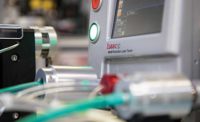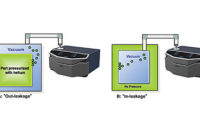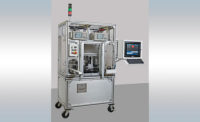Leak testing is an essential part of the manufacturing process for a variety of products, ranging from cardiac pacemakers to automotive radiators.
Compared with, say, screwdriving or ultrasonic welding, leak testing is among the more time-consuming processes on an assembly line, especially if the product being tested is relatively large. Testing time can vary from a few seconds for small assemblies up to a several minutes for larger ones, and that can create a bottleneck on the assembly line. Fortunately, suppliers of leak test instruments know many ways to reduce cycle times and make the process more efficient.
According to Jacques Hoffmann, president of InterTech Development Co., many factors affect how long it takes to perform a leak test, such as product volume, product material, type of leak test, leak rate specification and temperature. These factors, alone and in combination, can add time to the leak test.
Product Volume
Doug Harding, vice president of sales at Zaxis Inc., explains that the volume of the object being tested will correlate to how much time is needed to test it. Leak testing is accomplished by pressurizing or depressurizing the product, so the smaller the volume, the faster it can be tested. Since the size and volume of products depends on the application, redesigning them to be smaller is generally not a viable option to save time on leak testing.
“One way to save time is to reduce the testable volume by designing tooling to reduce the volume of the product,” says Paul Chamberlain, LACO Technologies’ CEO and president. “If you can cut the test volume in half, you can cut the cycle time in half.”
Gordon Splete, product and marketing manager at Cincinnati Test Systems Inc., agrees. He suggests using filler blocks to reduce the internal or external volume of the product, depending on the type of test. The smaller volume means shorter test cycle times.
Leak Rate Specification
Other than the product’s volume, the leak rate is the determining factor on how long the leak test will take, according to Thomas Parker, automotive leak testing sales manager at Inficon. The smaller the leak rate, the longer it will take to test. Different types of leak testing can be more efficient for certain leak rates. For machine castings that have a small leak rate, Barry Money, president of LeakMaster, suggests using differential pressure testing. This method is faster, but it is more expensive and requires additional tooling.
Mass flow testing is better with flexible parts because it doesn’t allow the product to expand, but it is also more expensive, because it requires additional sensors and tooling. In the mass-flow method, the test part is pressurized along with a reference volume. The test part and the reference volume are then isolated from the pressure source and connected to each other. If the test part has a leak, air will flow from the reference volume to the test part to replace the air that escaped. A transducer can measure that flow directly in standard cubic centimeters per minute.
Helium and tracer gas testing can speed up testing for large parts and is ideal for detecting small leaks. However, the gases are costly, and the system that measures and controls the gases is also more expensive than a pressure decay test system.
Pressure decay testing is the lower cost investment, which makes it the most accessible leak test. While other test methods may be faster, there are ways to cut time out of the pressure decay test cycle. Chamberlain explains that understanding the required leak rate for the specific product and application can save time. Manufacturers often test for a smaller leak rate than necessary, simply because that’s the way it had always been done.
Parker advises assemblers to consult with leak test suppliers to ensure that they are testing the correct rate for the product, industry and application. This can save time as well as resources by minimizing the number of products that might fail with the incorrect rate.
Factoring in Stabilization
For manufacturers that choose to use the pressure decay method, temperature can extend the cycle times. Money suggests temperature control is critical for repeatability, as heated parts can lose rigidity and provide inaccurate results. Certain materials are more sensitive to temperature changes, which can cause them to expand and deform, increasing the internal volume.
Much of the cycle time in a leak test is the stabilization or settling step, when the part heats up and flexes during pressurization. If the product isn’t given enough time to settle, the test results can be skewed and show the part as a false failure. Restraining the part to prevent or limit flexing and deformation allows the products to be tested without waiting for settling.
Chamberlain agrees that restraints work, but he also suggests overpressurizing the part slightly to stress it, which helps it to stabilize more quickly.
Testing Device Components
The leak testing device can also play a role in how long the test cycle takes. Having a device that can accurately detect leaks is crucial, be it the sniffer probe for tracer gas methods or a transducer for pressure decay. The more resolution you can get from a transducer, the faster you can detect pressure change, says Splete.
Harding recommends that the part being tested is as close as possible to the leak tester. This often requires a smaller leak testing unit that can be integrated into an automated system. Pressure decay testing can be sped up by getting air in and out as quickly as possible. Assemblers can use larger fill lines and flow valves that allow air to flow in and exhaust quickly. It’s also possible to pressurize multiple ports at the same time.
Properly designed seal tooling and fixturing will compensate for a lack of rigidity. Tooling that restricts flexing can minimize cycle time. In addition, proper sealing of all openings as well as the hose will minimize the time needed to pressurize the product. Parker recommends adding vacuum pumps to evacuate the part or test chamber faster, once the test have been completed.
Some manufacturers may choose to test the product in a vacuum chamber that applies negative pressure to the exterior of the part rather than the interior. This can reduce cycle times by allowing the measurable volume to be reduced. However, it can add additional costs to have a pressurized chamber and equipment.
Ask the Pros
The most common tip from the leak test manufacturers is to be realistic about the application and ask the professionals. Harding explains that education can help speed up the leak testing process, by knowing what tests need to be done. Leak test manufacturers have experience testing a wide variety of products in a number of industries and are more than happy to share their knowledge with their customers. They can give you an idea of how long the cycle will take, as well as how the specific part contributes to overall test time.
Many leak testing suppliers are willing to build turnkey testing systems that fit the customer’s exact requirements. Such systems look at the test instruments as well as the way the whole system functions.
Leak test manufacturers want to make the testing process as cost effective and efficient as possible for their customers. By working with the customer, they can ensure that the leak rate is accurate and the customer is using the most effective test method for the application. While customers may have similar products and applications, there are no one-size-fits-all solutions in leak testing. Use the knowledge and experience of the manufacturers to create the most efficient leak test system for your application.








